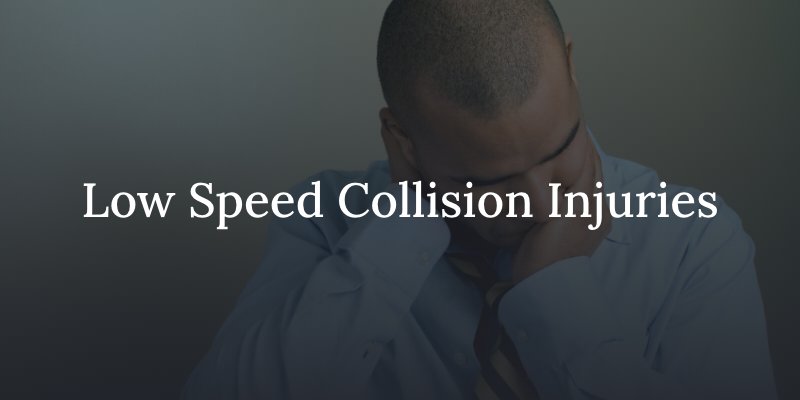Common Injuries After a Low-Speed Collision
Request Free ConsultationSome car accidents are catastrophic scenes, occurring at high speed and ending in totaled vehicles and severe injuries. Other car accidents occur at lower speeds and end in only minor damage to a vehicle. In accidents that appear to be little more than fender-benders, insurance companies commonly dispute injury claims on the erroneous basis that it’s unlikely a serious injury could have occurred in an accident with little damage to a vehicle. Unfortunately, low-speed collisions may result in significant injuries, sometimes injuries with temporary or permanent life-altering effects.

What is a Low-Speed Collision?
Although there is no clear legal definition of a low-speed collision, most experts consider these “fender-benders” as accidents occurring at speeds of 10 to 25 miles per hour. Common examples of low-speed accidents include the following:
- Rear-end collisions in slow, congested traffic situations
- Sideswipes during merging or lane changing in slowed traffic
- Collisions between vehicles driving in parking lots
- School zone collisions
- Collisions at stop signs
- Reversing driver accidents
- Sliding into obstacles or other vehicles on icy or snowy roads
When low-speed accidents occur, there may still be a significant crash force. For example, according to the Montana DOT crash force calculator, a 120-pound person becomes a 3,000-pound force in an accident at only 25 miles per hour. This force thrusts the motorist forward against the seat belt and then snaps them back against the seat.
Whip Lash and Other Low-Speed Accident Injuries
Injuries can occur to motorists even in low-speed collisions. One of the most common low-speed accident injuries is whiplash. Whiplash occurs when the sudden, whip-like back-and-forth motion of a person’s head in a collision causes hyper-extension of the structures in the neck. Whiplash symptoms may be mild during the hours after an accident and then slowly worsen as inflammation sets in. Stiffness, pain, headache, reduced range of motion, and other symptoms can significantly impact the victim’s quality of life for weeks, months, or even a year or more until the symptoms resolve with treatment.
Other low-speed accident injuries include the following:
- Neck injuries
- Lower-lumbar injuries and other back injuries
- Knee injuries
- Wrist injuries
- Concussion
- Facial injuries from airbag deployment
- Bruises and soft-tissue injuries
Although these are not the catastrophic or deadly injuries associated with high-speed accidents, they can still cause significant damages like medical expenses, lost wages, and pain and suffering.
What to Do After a Low-Speed Car Accident with Injuries
After any accident—even one that occurs at low speed—accident victims know they’re supposed to exchange insurance information and report the accident, but it’s important to take additional steps, even if you don’t feel as though you’re seriously injured. At the scene of an accident, always do the following:
- Report the accident
- Use your cell phone camera to take photos of the accident scene, including anything relevant to the cause of the accident such as a stop sign, signal light, or road hazard
- Take photos of the damage to vehicles, even if it’s minor
- Take photos of any visible injuries
It always pays to go to a hospital or urgent care center after an accident to have a thorough medical exam, even if you feel your injuries are minor. Many low-speed car accident injuries such as whiplash and concussions have delayed symptoms onset. A medical exam may detect these injuries so you receive care and have documented evidence that the injury occurred in the low-speed collision. This makes it easier for you and your Kansas City car accident lawyer to make a compelling claim for compensation for your damages.

